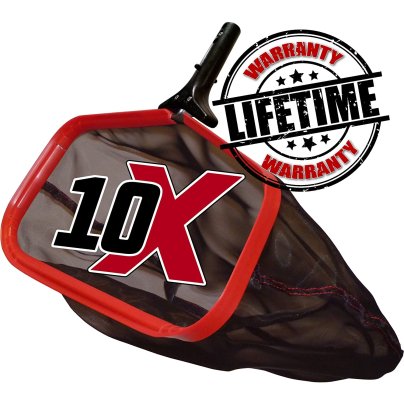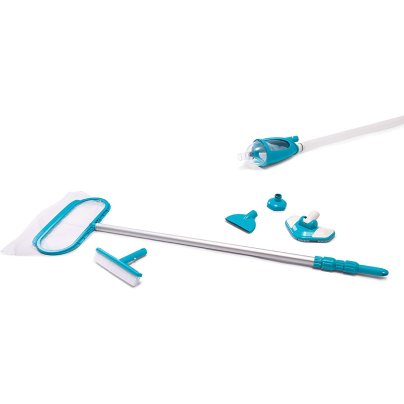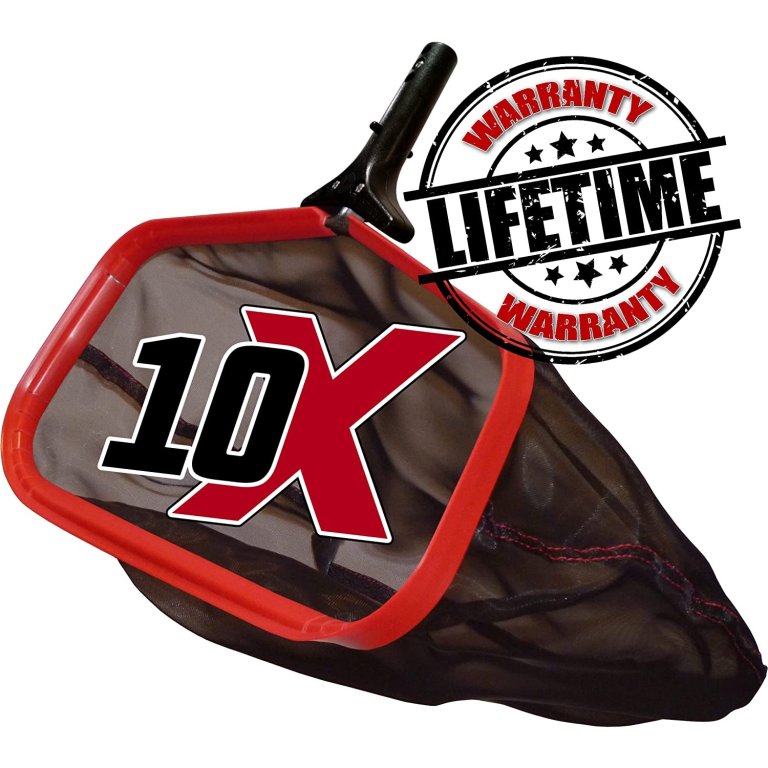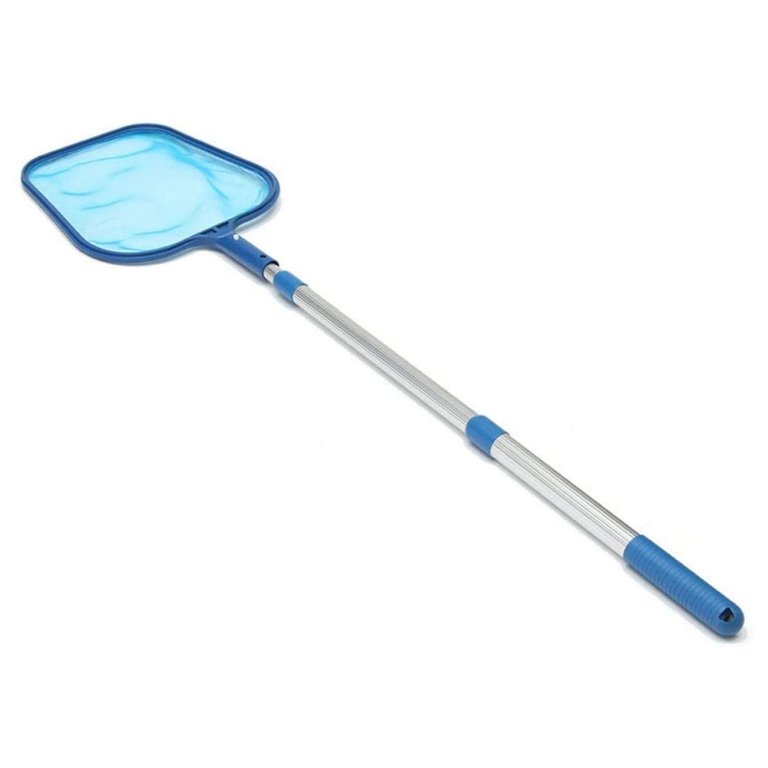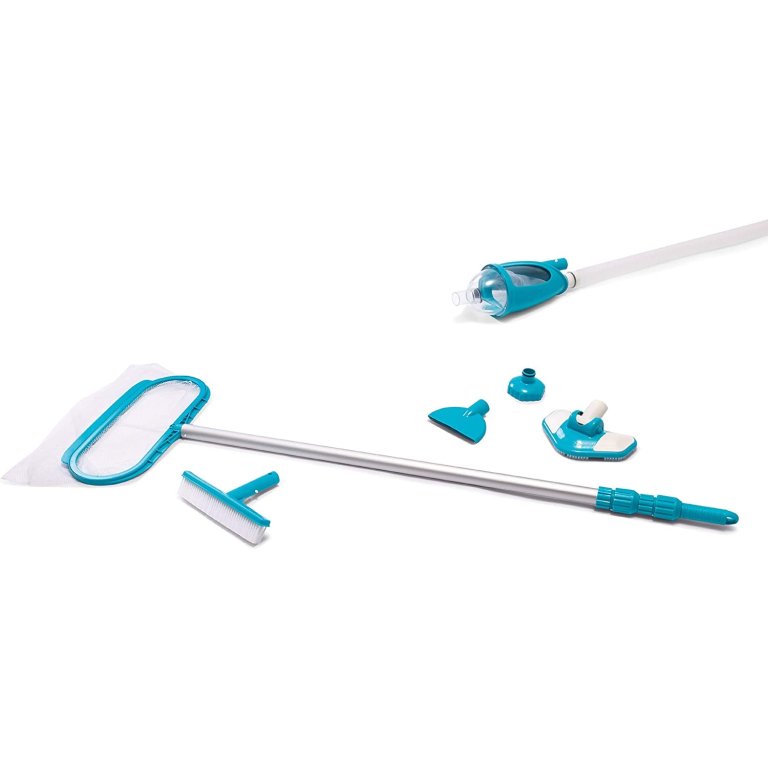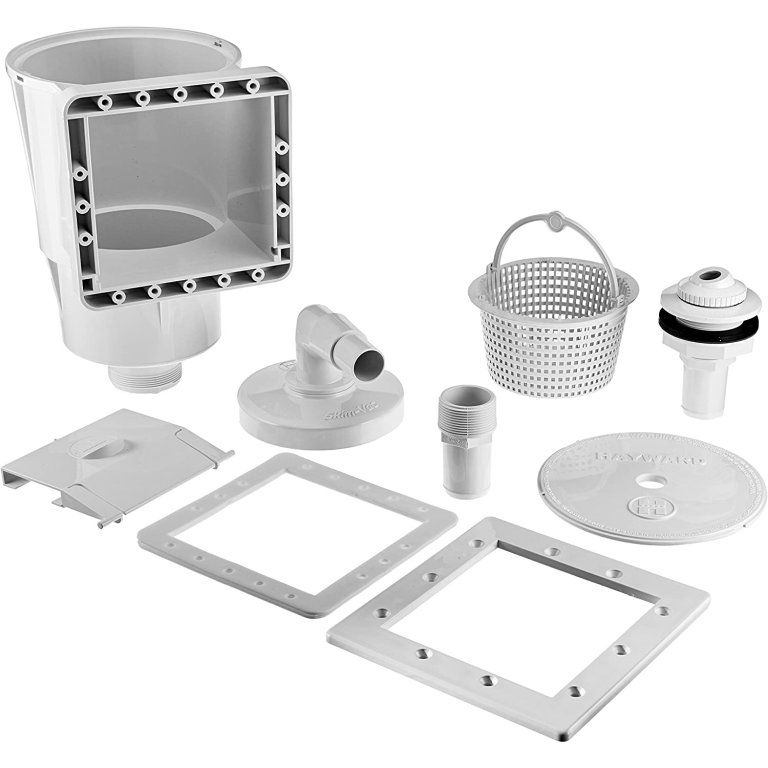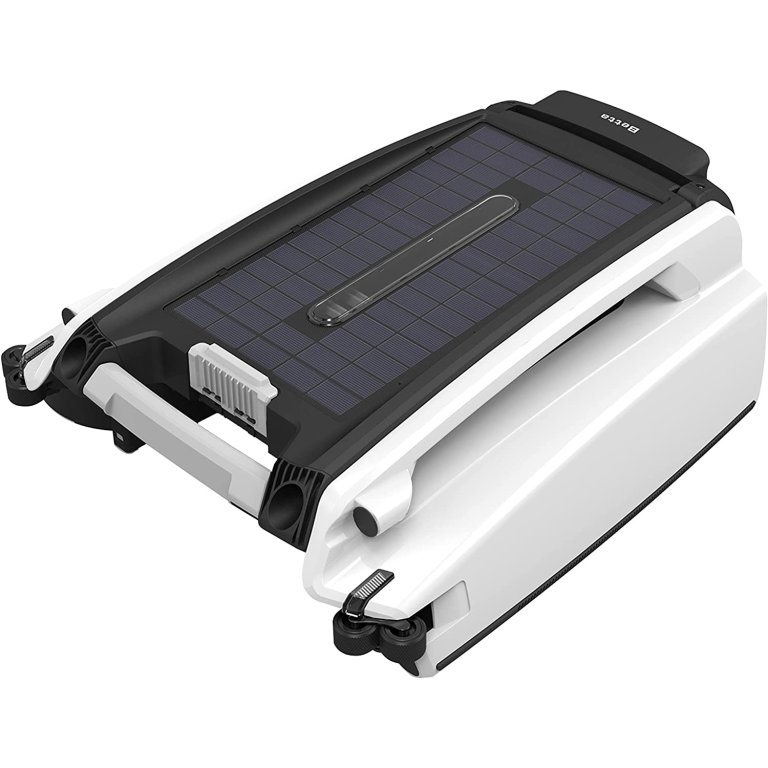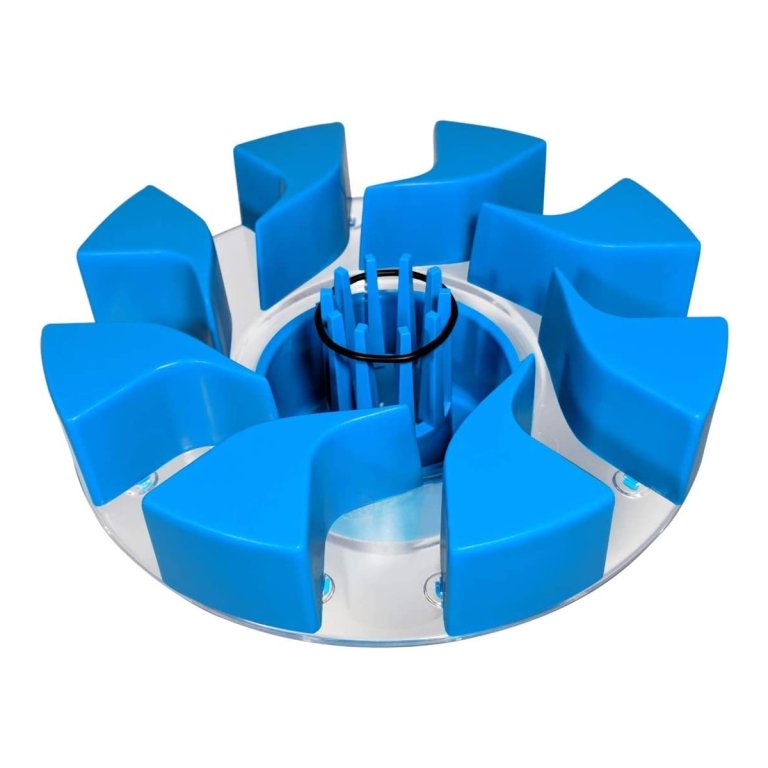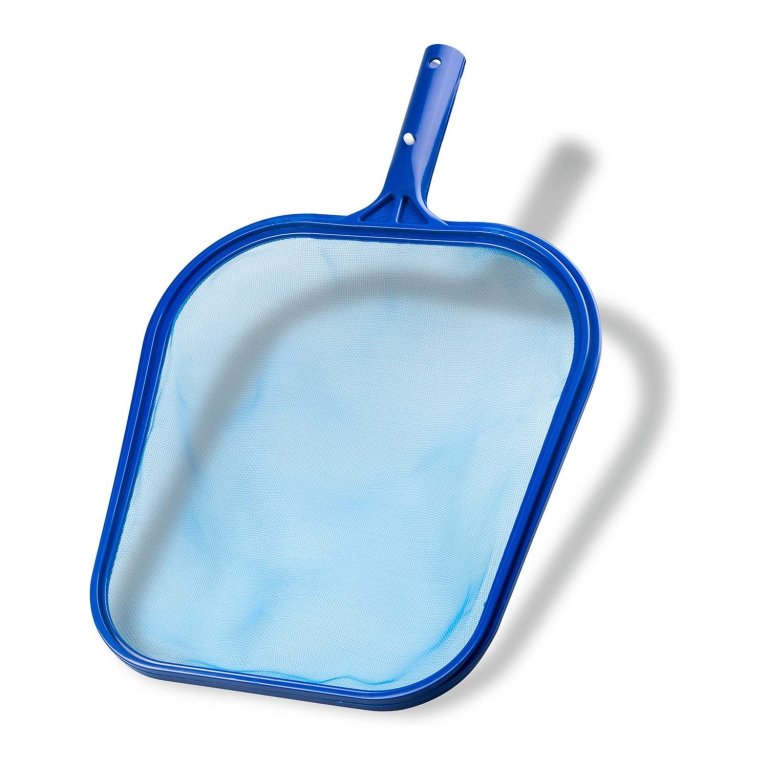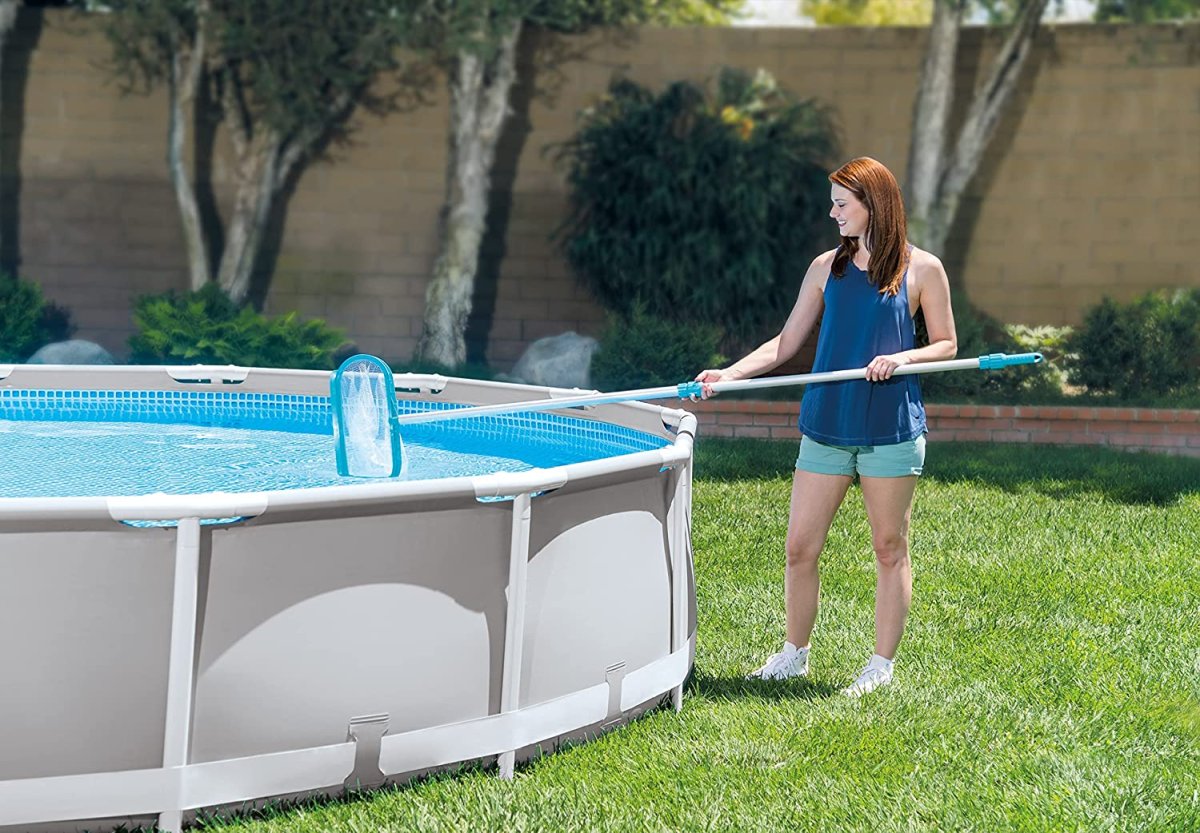
We may earn revenue from the products available on this page and participate in affiliate programs. Learn More ›
Pool skimmers are one of those tools no pool owner can do without. Even if the pool is regularly serviced by a maintenance company, there will be many times when leaves, dead bugs, pet hair, and other debris collect on the surface, and all of that unwanted stuff will need to be cleaned away. Clearing it away with a skimmer not only keeps the pool looking great, it also helps ensure that the water is safe for swimming.
There are many different pool skimmers available, from simple nets to solar-powered robots. It’s always nice to have plenty of choice, but it’s not always easy to pick the right model. Features and costs vary enormously among today’s pool skimmers. With this guide, we set out to help by looking at both the practical and technical aspects of popular devices and then created a list of recommendations. Here are some of the best pool skimmers available right now.
- BEST OVERALL: ProTuff Heavy Duty Fine Mesh Pool Skimmer
- BEST BANG FOR THE BUCK: GKanMore Pool Skimmer Net With Telescopic Pole
- BEST KIT: Intex Deluxe Pool Cleaning Maintenance Kit
- BEST ABOVE-GROUND: Hayward SP1091LX Dyna-Skim Above-Ground Pool Skimmer
- BEST ROBOTIC: Betta 2 Solar-Powered Smart Robotic Pool Skimmer
- BEST FLOATING: SkimmerMotion Original Automatic Pool Cleaner
- ALSO CONSIDER: Evob Leaf Skimmer Net
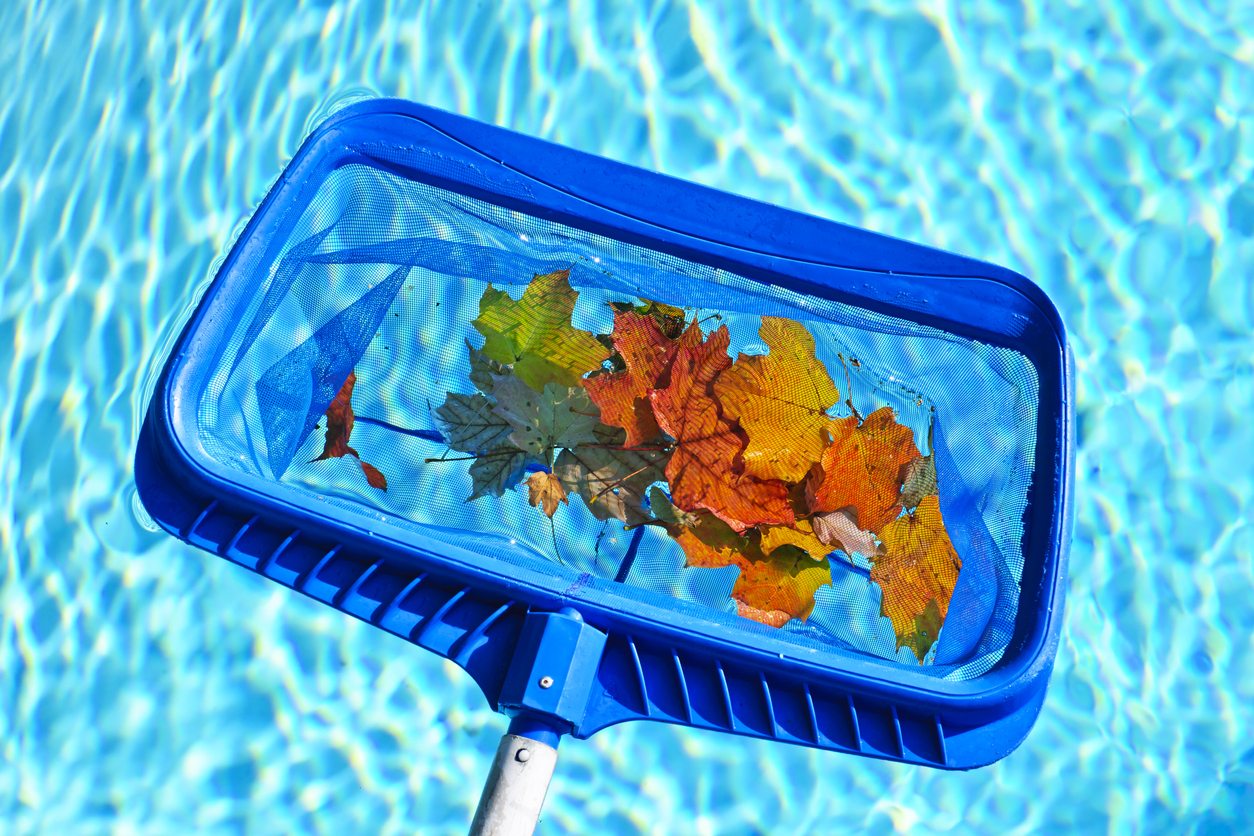
How We Chose the Best Pool Skimmers
Our key task in developing this curated list of the best pool skimmers is to offer quality examples that represent the many different types available. Some people may want nothing more than a low-cost pool skimmer net. Others may be happy to invest in a robotic pool skimmer for effortless operation. We looked at all of the leading manufacturers and dozens of different devices in order to put together a comprehensive selection.
Skimmers suitable for inground and above-ground pools were considered. There are manual and automatic models. Some shoppers may enjoy pool accessories and gadgets, but many people don’t want to spend hours cleaning the pool, so ease of use and low maintenance requirements were major factors. Value for money is often a big deal among our readers, and durability is a big part of that. We also reviewed owner comments to get real-world feedback on day-to-day performance and to learn about any common faults.
Our Top Picks
The following list offers everything from a budget-friendly pool leaf skimmer to an environmentally friendly floating robot. Each has been categorized so potential buyers can quickly find the pool skimmer they need.
Best Overall
ProTuff Heavy Duty Fine Mesh Pool Skimmer
Pros
- Heavy-duty double-stitched net can hold up to 50 pounds of debris
- Corrosion-resistant aluminum frame with winged handle for strong net support
- Designed both for surface skimming and cleaning the pool bottom (suitable handle required)
Cons
- A handle will need to be purchased separately
Product Specs
- Type: Manual
- Pool suitability: All
- Collection method: Net
Pool skimmer nets are popular because they are a convenient and easy-to-use tool for keeping a pool at its best. However, many are relatively small. The ProTuff pool skimmer is quite the opposite. The double-stitched net has a capacity of up to 50 pounds, and the aluminum frame is both strong and corrosion-resistant.
Unlike shallow nets that are really only good for picking small items off the surface, the ProTuff net can collect debris from both the surface and the bottom. The fine mesh collects small particles while still allowing water to flow through easily, thus minimizing effort. There is also a winged handle section to provide vital support for heavy loads.
The ProTuff heavy-duty pool skimmer is very popular, and complaints are extremely rare. However, a handle is not included. ProTuff makes their own telescopic pole for pool skimmer use that is very strong, but more affordable alternatives are also widely available.
Get the ProTuff pool skimmer at Amazon.
Best Bang For The Buck
GKanMore Pool Skimmer Net With Telescopic Pole
Pros
- Budget-friendly fine-mesh net for everyday pool skimming captures even small bugs
- Corrosion-resistant aluminum pole can extend to more than 3 feet
- Also available as net only or with 5-section pole; both with low prices
Cons
- Limited capacity means it can take longer to clear a pool than other skimmers
Product Specs
- Type: Manual
- Pool suitability: All
- Collection method: Net
The fact that the GKanMore pool skimmer comes at such a low cost means it’s easy to underestimate its usefulness. However, it will likely be the ideal solution for many people. Those who have a pool maintenance contract still need a skimmer like this for everyday use. And those who have a pool vacuum still need a skimmer to trap the everyday floating debris.
The GKanMore meets these needs. It is made from plastic, polypropylene, and features an aluminum pole that won’t rust. The fine mesh traps even small items but glides easily through the water so it doesn’t take a lot of effort. The telescopic pole can be adjusted for reach from 17.3 inches to 41.3 inches, so it’s suitable for most pools.
The plastic frame isn’t particularly strong, so care needs to be taken not to overload it. Still, for light-duty pool skimming, the GKanMore skimmer represents excellent value for the money.
Get the GKanMore pool skimmer at Amazon.
Best Kit
Intex Deluxe Pool Cleaning Maintenance Kit
Pros
- Inexpensive yet comprehensive kit for pool skimming and general cleaning
- Made by long-established Intex brand known for high-quality pools and related products
- Telescopic aluminum pole is lightweight and offers reach for pools up to 18 feet across
Cons
- Requires a 800-GPH Intex filter pump or similar for full functionality
Product Specs
- Type: Manual
- Pool suitability: Primarily above-ground (see description)
- Collection method: Net, vacuum, scrub brush
The Intex brand is well known for high-quality pools and accessories. This comprehensive kit includes a skimmer net, a scrub brush, a vacuum attachment, and a telescopic pole with a maximum 110-inch reach. Although intended for above-ground pools, the skimmer net and brush could also be used with inground models.
The skimmer net is deep enough to collect a considerable amount of debris, and the frame is molded to collect items that have sunk to the pool floor. Most parts are plastic or polypropylene, which is easy to keep clean. The pole is made from lightweight rust-resistant aluminum.
The Intex pool skimmer and maintenance kit is certainly comprehensive, but it does require an 800-GPH (gallons per hour) filter pump to take advantage of the vacuum attachment. While problems aren’t common, some users feel the vacuum attachment connections come loose too easily.
Get the Intex pool skimmer at Amazon or The Home Depot.
Best For Above-Ground
Hayward SP1091LX Dyna-Skim Above-Ground Pool Skimmer
Pros
- Made from ABS plastic that offers high strength and UV resistance
- High-capacity waste basket is easy to access and has handle for lifting
- It’s straightforward to assemble and install using just basic DIY tools
Cons
- Faults are rare though problems with thread attachments have occasionally been reported
Product Specs
- Type: Automatic
- Pool suitability: Above-ground
- Collection method: Basket
Few manufacturers have a better reputation for above-ground pool skimmers than Hayward. The Dyna-Skim is an automatic model made from ABS plastic that is both strong and resistant to ultraviolet (UV) damage, thus providing good durability. It has recently been redesigned to suit modern pools that have a wide top seat, but is equally suitable for older models. A large pool skimmer basket with handle means less frequent emptying, and it’s easy to lift out when necessary.
Fitting the Hayward Dyna-Skim is straightforward, and only basic DIY tools are required. However, care should be taken because a hole needs to be cut in the side of the pool. The vast majority of buyers are happy with their purchase, though cracks in thread attachments have occasionally been reported.
Get the Hayward pool skimmer at Amazon or The Home Depot.
Best Robotic
Betta 2 Solar-Powered Smart Robotic Pool Skimmer
Pros
- Can run fully automated using built-in sensors or be directed manually via remote control
- Eco-friendly solar power with LED indicators provide useful status feedback
- Anti-strand bars help prevent the device from getting stuck in shallow water or on steps
Cons
- Much more expensive than other manual options on this list
Product Specs
- Type: Automatic
- Pool suitability: All
- Collection method: Internal tray
The Betta 2 robot is perhaps the ultimate in automatic pool skimmers. It is propeller-driven and runs on solar power. Built-in sensors identify pool edges or other obstacles so it can simply be put into the pool and left to navigate its way around. Should it need to be directed, there is a cordless remote for manual control.
The twin Superior Continuous Torque (SCT) motors are both chlorine and salt tolerant, so it can run in most any pool water. An intake impeller guides leaves and other debris into the internal tray. A convenient handle makes it easy to empty. Adjustable anti-strand bars help prevent the Betta 2 robotic pool skimmer from getting stuck on steps or shallow areas of the pool. LED status indicators provide a variety of useful feedback.
The Betta 2 skimmer is a remarkable device, but the investment required is considerable. Plus, it is only a pool surface skimmer, so it won’t tackle the sides or bottom of the pool.
What Our Team Says: Bob Vila Executive Editor and product tester, Stephanie Cronk, says, “When testing our robotic pool cleaners, we found this to be by far one of the most useful tools we’ve come across. We live in an area that has a lot of pollen and cottonwood flying around; so much so that some days we joke that it’s snowing out. Since we’ve been using this unit, our pool stays clear of bugs and debris. It’s also worth noting that my pool sits in the shade for half of the day and that does not affect this unit’s ability to clean”
Get the Betta pool skimmer at Amazon or The Home Depot.
Best Floating
SkimmerMotion Original Automatic Pool Cleaner
Pros
- Floats on the surface of the pool using a whirlpool action to collect debris
- Saves time and effort by automatically working with the pool vacuum
- Durable construction has no moving parts, and it’s made in the U.S.
Cons
- Requires some form of pool vacuum and will not trap particles greater than 1 inch across
Product Specs
- Type: Automatic
- Pool suitability: Inground and some above-ground
- Collection method: Vacuum
A good pool vacuum can keep the bottom of a pool clean, but it can’t tackle the surface debris that can contaminate the water. The SkimmerMotion is a floating pool skimmer that attaches to the vacuum via its own hose, and then follows it around the pool collecting leaves, bugs, and other debris as it goes.
The shape of the SkimmerMotion paddles creates a whirlpool action that draws material towards it for collection. Assembly is quick and easy, and the device is compatible with any pool vacuum cleaner.
A pool pump rated at least 1 horsepower is recommended for the SkimmerMotion. The size of the vacuum pipe attachment means that debris larger than 1 inch across cannot be collected. While designed for inground pools, it could be used in above-ground pools that can safely accommodate a vacuum pool cleaner.
Get the SkimmerMotion pool skimmer at Amazon.
Also Consider
Evob Leaf Skimmer Net
Pros
- Simple, low-cost solution for day-to-day removal of leaves and other debris
- Plastic frame and nylon mesh make it light and easy to maneuver
- Compatible with most standard and telescopic poles (0.79 inch to 1.25 inch in diameter)
Cons
- Pool skimmer is only for light-duty use
- A pole is not included so will need to be purchased separately
Product Specs
- Type: Manual
- Pool suitability: All
- Collection method: Net
The Evob leaf skimmer net is an affordable pool-cleaning essential for day-to-day debris removal, and it’s the kind of simple everyday tool that is ideal to keep handy near a pool. It’s lightweight and easy to maneuver for scooping up leaves or other small items of debris found floating on the pool’s surface to help prevent water contamination.
The frame is plastic, and the mesh is nylon, so it won’t come to any harm if it is left out in inclement weather. However, it isn’t a heavy-duty pool skimmer and a pole isn’t provided. The Evob pool skimmer will accept standard or telescopic models from 0.79 inches to 1.25 inches in diameter.
Get the Evob pool skimmer at Amazon.
Jump to Our Top Picks
Types of Pool Skimmers
There are a couple of different ways to think about pool skimmer types. First, there’s the type of pool they suit, and second, there’s the way that the pool skimmer operates. When it comes to pool type, there are a number of models that will work for both inground or above-ground pools, but there are some that are only suitable for one or the other.
Manual and automatic pool skimmers also vary in cost and complexity. In the following sections, we look at each of these aspects in more detail.
Manual
The simplest manual pool skimmer is basically a shallow net on a pole. The main advantage of manual pool skimmers is price. These are the low-budget solutions, and they do a perfectly good job of fishing a few leaves out of the water.
If they have drawbacks, it’s that they often can’t pick up very much, they may not be especially durable, and they always require physical effort. Lifting a net containing 20 or 30 pounds of wet leaves while leaning over a pool is not easy.
There are some manual skimmers that are larger and stronger than others. There are also pool maintenance kits that have skimmer heads and attachments for other pool-cleaning tasks.
Automatic
Automatic pool skimmers come in three formats: stationary, floating, and robotic.
Stationary pool skimmers are fitted to the side of above-ground pools, and they are connected to the water pump/circulation system. Leaves and other debris fall into a skimmer basket on the outside of the pool so it is easy to empty.
Floating pool skimmers are designed to be attached to pool vacuums. While the vacuum cleans the bottom of the pool, the floating skimmer creates a whirlpool that draws in material from the surface.
Robotic pool skimmers run independently of the pool pump, and they swim across the surface picking up floating waste as it goes. A pool robot skimmer is usually a cordless solar-powered device. While initial investment is higher, there are no running costs as such, and they are often environmentally friendly.
What to Consider When Choosing a Pool Skimmer
Before deciding on either a manual or an automatic pool skimmer, there are a number of other features that are frequently considered. It’s worth taking a few minutes to think about these as they impact initial cost and how the pool skimmer will be used on a day-to-day basis.
Pool Type
Manual pool skimmers will work with virtually all pool types. It can sometimes be awkward to reach all of the way around an above-ground pool with a net, but standing on some kind of movable step or platform will get the job done (do make sure it is stable).
Stationary pool skimmers are described as suitable for above-ground pools, but it’s important to check installation requirements. Some hang or clamp a pool filter basket on the edge, but others need a hole cut into the side of the pool for installation. Stationary pool skimmers are not suitable for inground pools.
Robotic pool skimmers also work for all pool types because they paddle around on the surface. Floating pool skimmers need to work in conjunction with a pool vacuum. While the device itself presents no problems with above-ground pools, the vacuum may not be suitable for and might actually damage soft-sided pools.
Maintenance and Ease of Use
The majority of pool skimmers are easy to look after and require minimal maintenance. However, overlooking maintenance will usually reduce the tool’s effectiveness and shorten its useful life, so it’s worth considering basic upkeep.
With manual pool skimmers, it’s really just a question of emptying the net. The contents can usually be added to the compost heap. However, because manual skimmers are very low cost, they do get neglected. If left lying on the lawn, someone may eventually stand on it. Or moisture might get into any metal parts and cause rust. Simply standing it against a wall under cover will prevent most problems.
Stationary pool skimmers are mostly made from strong plastic and are usually maintenance-free beyond emptying the basket and an occasional wipe with a damp cloth. Floating pool skimmers collect waste in the attached vacuum, so they need minimal maintenance of their own.
Robotic skimmers have an internal collecting tray that needs to be emptied. Solar panels are less effective if dusty, so wiping them off regularly is a good idea.
Capacity
The capacity of a particular pool skimmer is going to affect how much debris can be collected and how often it needs to be emptied.
- Net size is usually the determining factor on manual pool skimmers, and some have a weight rating.
- Above-ground pool skimmers have a collecting basket, so check the size of the basket before ordering.
- With floating pool skimmers, it’s the vacuum that determines how much can be collected.
- Robot pool skimmers have an internal tray, so check the size of the tray before purchasing.
The frequency of cleaning out the collection tray or basket will depend on the amount of debris collected. If the pool is in an open area, for example, it will gather fewer leaves than a pool with shade trees nearby.
With most pool skimmers, it is best to empty the device as soon as the job is finished, or waste can start to rot inside the net or tray. While stationary models with collecting baskets are the exception, clearing them regularly is still a good idea.
FAQs
There is a lot to consider when searching for a new pool skimmer to keep your backyard swimming pool clean, and you may have a few lingering questions. Below are some answers to a few frequently asked questions.
Q. How long should a pool skimmer last?
How long a pool skimmer lasts very much depends on the type and how well it is looked after. Even low-cost nets will last several years if cleaned carefully and not just left lying around on the lawn or poolside.
It’s difficult to be accurate with the expected longevity of robotic pool skimmers as these are relatively new, though experts we consulted suggest that 5 to 8 years is reasonable. Pool skimmers with baskets for above-ground pools are rated for 20 years plus.
Q. Where should a pool skimmer be placed?
Where feasible, the skimmer should be placed on the side of the pool nearest the house so it isn’t seen from that side. Fixed pool skimmers need to be around half full with water, and a position facing the normal wind direction is usually a good idea as this will help blow debris into the pool skimmer opening. However, always follow the manufacturer’s instructions for optimal performance.
Q. Do you really need a skimmer in a pool?
You certainly need a pool skimmer of some kind in order to keep pool water clean and safe for swimming. Whether you choose a manual net, fixed, or robotic pool skimmer is a matter of personal choice. The above article offers lots of guidance to help you pick the best pool skimmer for your needs.
Q. How often should you use a pool skimmer?
To keep the water in pristine condition, manual pool skimmers are used once a day. It only takes a few minutes if done regularly. It not only keeps the water clean, but it also helps prevent debris from clogging pump filters, which can cause overheating and shorten their life.
The same frequency is good for floating pool skimmers and robots. Given that you shouldn’t swim with them in the pool, many people will only run them once a week. A manual net can take care of daily chores, and it’s a very low-cost addition. Pool skimmers attached to the sides of above-ground pools run whenever the pump is working.
Q. How many pool skimmers do you need?
Assuming this refers to fixed pool skimmers, then leading pool skimmer manufacturer Haywards recommends one skimmer for every 400 square feet of pool surface. Several other sources we checked agree with this figure. However, it’s also advised not to have too many pool skimmers. If they are positioned too close together they can interfere with each other’s effectiveness.
Researcher and product specialist Bob Beacham has been writing consumer advice articles for national publications for more than a decade. He covers a wide variety of home and garden subjects and is known for providing information that is thorough yet easy to understand.
